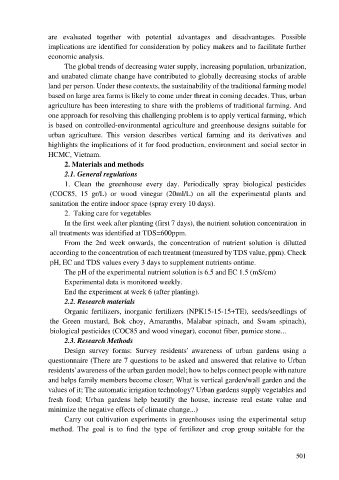Page 509 - Ebook HTKH 2024
P. 509
are evaluated together with potential advantages and disadvantages. Possible
implications are identified for consideration by policy makers and to facilitate further
economic analysis.
The global trends of decreasing water supply, increasing population, urbanization,
and unabated climate change have contributed to globally decreasing stocks of arable
land per person. Under these contexts, the sustainability of the traditional farming model
based on large area farms is likely to come under threat in coming decades. Thus, urban
agriculture has been interesting to share with the problems of traditional farming. And
one approach for resolving this challenging problem is to apply vertical farming, which
is based on controlled-environmental agriculture and greenhouse designs suitable for
urban agriculture. This version describes vertical farming and its derivatives and
highlights the implications of it for food production, environment and social sector in
HCMC, Vietnam.
2. Materials and methods
2.1. General regulations
1. Clean the greenhouse every day. Periodically spray biological pesticides
(COC85, 15 gr/L) or wood vinegar (20ml/L) on all the experimental plants and
sanitation the entire indoor space (spray every 10 days).
2. Taking care for vegetables
In the first week after planting (first 7 days), the nutrient solution concentration in
all treatments was identified at TDS=600ppm.
From the 2nd week onwards, the concentration of nutrient solution is dilutted
according to the concentration of each treatment (measured by TDS value, ppm). Check
pH, EC and TDS values every 3 days to supplement nutrients ontime.
The pH of the experimental nutrient solution is 6.5 and EC 1.5 (mS/cm)
Experimental data is monitored weekly.
End the experiment at week 6 (after planting).
2.2. Research materials
Organic fertilizers, inorganic fertilizers (NPK15-15-15+TE), seeds/seedlings of
the Green mustard, Bok choy, Amaranths, Malabar spinach, and Swam spinach),
biological pesticides (COC85 and wood vinegar), coconut fiber, pumice stone...
2.3. Research Methods
Design survey forms: Survey residents' awareness of urban gardens using a
questionnaire (There are 7 questions to be asked and answered that relative to Urban
residents' awareness of the urban garden model; how to helps connect people with nature
and helps family members become closer; What is vertical garden/wall garden and the
values of it; The automatic irrigation technology? Urban gardens supply vegetables and
fresh food; Urban gardens help beautify the house, increase real estate value and
minimize the negative effects of climate change...)
Carry out cultivation experiments in greenhouses using the experimental setup
method. The goal is to find the type of fertilizer and crop group suitable for the
501

